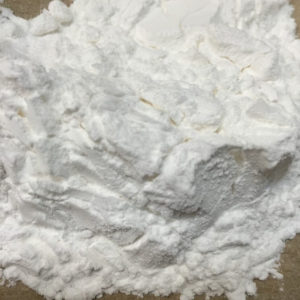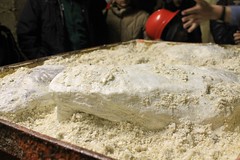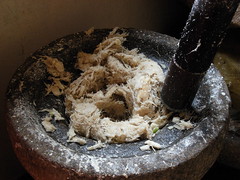Vegetable vs. Mineral, What’s The Best Body Powder To Use?
 The whole purpose of any powder is to cover the skin with a light silky coating. The goal is to create a protective layer and to wick water away from the surface. This is how powders work no matter what their chemical structure is. But they don’t all work exactly the same and some of them have some pretty big caution flags for personal care use.
The whole purpose of any powder is to cover the skin with a light silky coating. The goal is to create a protective layer and to wick water away from the surface. This is how powders work no matter what their chemical structure is. But they don’t all work exactly the same and some of them have some pretty big caution flags for personal care use.
Traditional Talc
 Traditionally, powders were made with mined minerals or clays. The most common mined mineral is Talc and you can find the use far and wide from industrial to pharmaceutical to cosmetic. Talc is hydrated magnesium silicate, a very fine substance and rates only a 1 on the MOHS scale of hardness for minerals. That means it is so soft you can actually flake it with your finger nail. It can be found in veins all over the globe and was formed hydrothermal alteration of magnesium-rich magmatic rocks. The mines are plentiful and it’s fairly cheap raw material. It also has a shelf life of eternity. All those factors make it very appealing for manufacturing. Unfortunately, it is usually found near asbestos veins as well but not always so not all talc contains trace amounts of asbestos. And recently there have been a few lawsuits citing Talc as a leading cause of cervical cancer. There are also some studies that link pulmonary disease with talc which has caused many pediatricians to recommend against using it for children.
Traditionally, powders were made with mined minerals or clays. The most common mined mineral is Talc and you can find the use far and wide from industrial to pharmaceutical to cosmetic. Talc is hydrated magnesium silicate, a very fine substance and rates only a 1 on the MOHS scale of hardness for minerals. That means it is so soft you can actually flake it with your finger nail. It can be found in veins all over the globe and was formed hydrothermal alteration of magnesium-rich magmatic rocks. The mines are plentiful and it’s fairly cheap raw material. It also has a shelf life of eternity. All those factors make it very appealing for manufacturing. Unfortunately, it is usually found near asbestos veins as well but not always so not all talc contains trace amounts of asbestos. And recently there have been a few lawsuits citing Talc as a leading cause of cervical cancer. There are also some studies that link pulmonary disease with talc which has caused many pediatricians to recommend against using it for children.
I checked the American Cancer Society to see where they stood on the matter and they had stated that there was no conclusive evidence linking Talc to causing cancer as long as there was no asbestos present in the talc. remember we talked about the fact that it is common to find the veins run close together. Here is a link to their article for you: Talcum Powder and Cancer
Clay: The Other Mineral
Next are other minerals we will just lump into one major category called Clay. There are a several different groups of clay based on the chemical combination of the minerals. All clay is hydrous aluminium silicates, made up of ultra fine mineral particles and some minor impurities. They can become plastic like when wet.
Fun fact on clay. Did you know that water had to be present in order for it to form? That makes clay rare in the solar system.
Clay is used in many products from creating ceramics to paint filler to rubber, plastics and hi gloss paper manufacturing. But the ultra fine grade is used in cosmetics. Just about every dry powder formulation and even in some wet ones like scrubs and face masks can be made using clay in part or as a whole. Still used today by aboriginal tribes, it can also work as a sunscreen. For skin care, the most common clay is the purified white kaolin, with and ultra fine texture that feels like silk to the touch when it is dry.
You can read more about my experiment and the observable differences here: I personally haven’t seen anything against it other than the fact that any mineral may have impurities and it can be “plastic like” when mixed with water and it felt goopy sticky when I mixed it with oil. Again, clay is pretty bountiful and fairly cheap to come by which makes it an common filler used by some to keep manufacturing costs down.
Pure Natural Botanical
 More recent in the skin care world and less common are powders made entirely from plant starches. Personally I think it’s pretty fantastic how starch is made. Plant sources for starch powder can be anything from tuberous plants to seeded ones. The most common plants are corn, wheat, and rice as a seed version. Less common would be coconut, beans and peas. Arrowroot, potato, and tapioca are all examples of starchy tuber plants. You can read more about how the starches we use in Très Spa formulations are created: From lush green plant to delicate soft white powder
More recent in the skin care world and less common are powders made entirely from plant starches. Personally I think it’s pretty fantastic how starch is made. Plant sources for starch powder can be anything from tuberous plants to seeded ones. The most common plants are corn, wheat, and rice as a seed version. Less common would be coconut, beans and peas. Arrowroot, potato, and tapioca are all examples of starchy tuber plants. You can read more about how the starches we use in Très Spa formulations are created: From lush green plant to delicate soft white powder
Plant starches are used in many products including pharmaceutical and paper making but most common are food based products. There are so many varieties of plant starches to choose from and each one has a slightly different texture and behavior. With such a variety there is a seemingly endless array of combinations when you add in other powdered food ingredients like honey, maple syrup, vanilla, and coconut. Hmm that has me thinking of a future product….. Plant starches are renewable and sustainable, they are digestible (your inside and your outside can deal with it), and they can qualify as certified organic. But they are way more expensive to formulate with and there is a variance in the texture and behavior based on the plant so that is probably why most manufacturers shy away from using pure botanical.
Hybrids, A Little Of This And That
There are some formulators that combine two groups into a hybrid mash-up. For example one may use talc with corn starch or maybe kaolin with rice powder. I do not know why other than to cut cost by using a cheap filler with a higher priced plant ingredient.
So What’s It Gonna’ Be?
Given all the information, which powder is the right powder for you comes down to a personal choice. And in some cases, what you are willing to risk. Personally, I would only use talc as a bug deterrent (sprinkled on the floor or window sills, works great to keep ants out of the house). Clay seems okay for masks and scrubs but based on my observations, I’m not sure how good it would be as a body powder. Seems like you would have to have a plant starch with it. Then there are the possible impurities and the fact it could never be classed as organic. Which aren’t to intimidating if it all stays on the surface but it doesn’t just stay on the surface.If there is one thing the recent multi million dollar lawsuits should demonstrate it is that what goes on the body goes in eventually.
Personally I have other things in life to worry about, the last thing I want to worry about is my body powder. That is why I kept it simple when I created the Très Spa Organic Dusting Powder I use only plant based ingredients so if what goes on the outside ever gets to the inside, I have nothing to worry about.
